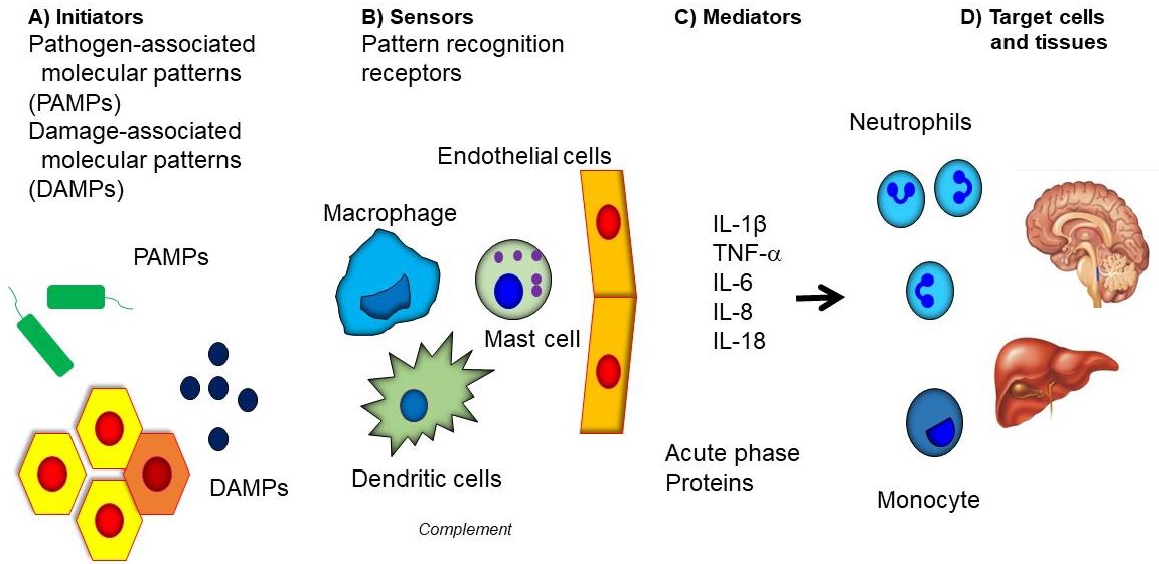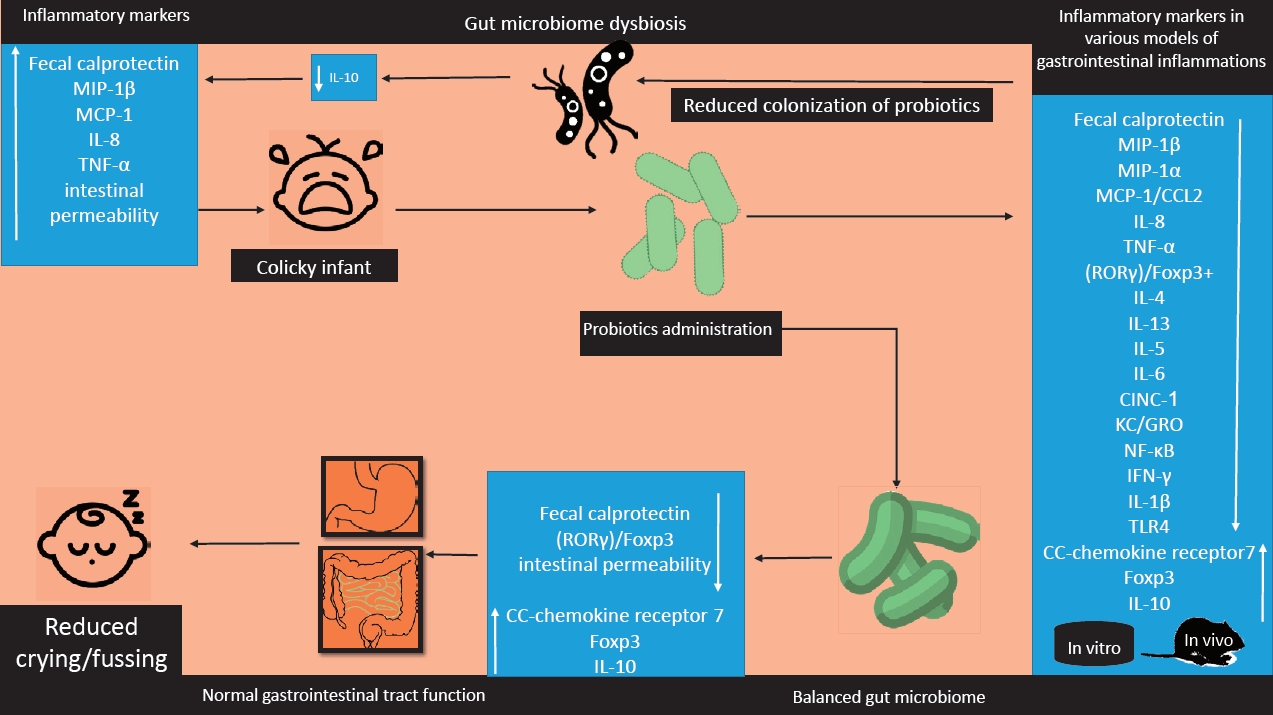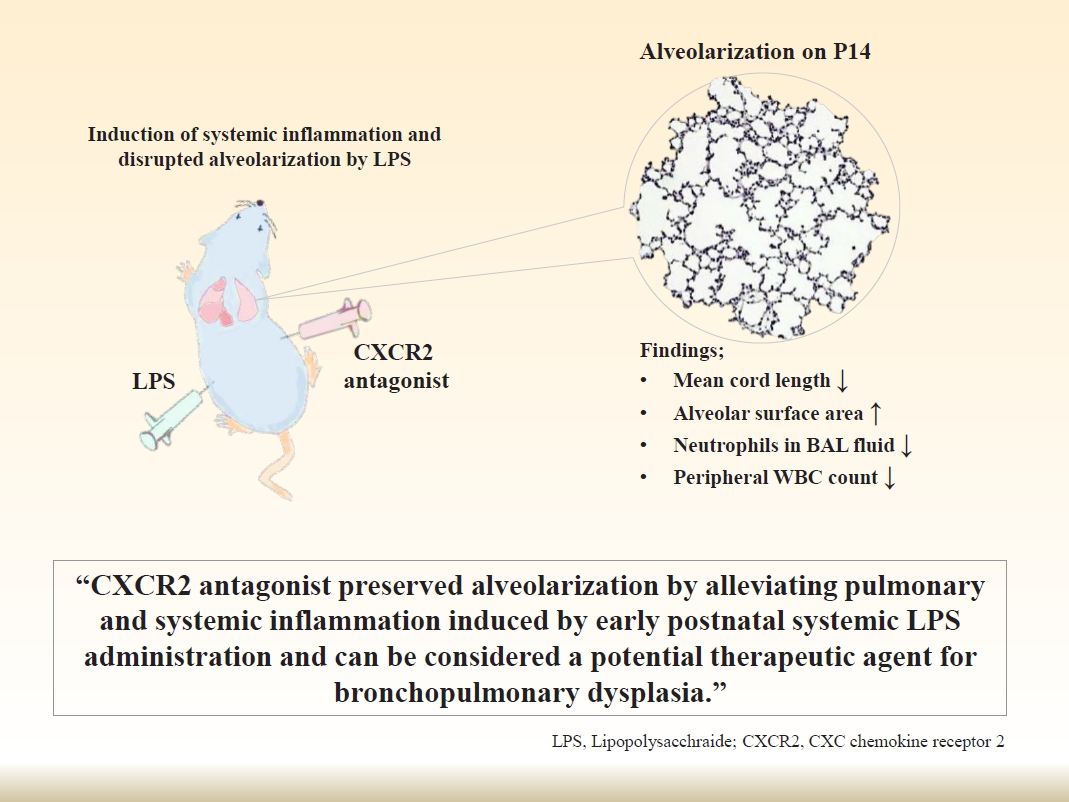Search
- Page Path
-
- HOME
- Search
- Original Article
- Adolescence Medicine
- Relationship between inflammatory biomarkers and insulin resistance in excess-weight Latin children
- Mariano Nicolás Aleman, María Constanza Luciardi, Emilce Romina Albornoz, María Cristina Bazán, Adela Victoria Abregú
- Clin Exp Pediatr. 2024;67(1):37-45. Published online December 21, 2023
-

Question: What is the prevalence of insulin resistance (IR) in excess-weight Latin children, and can proinflammatory biomarkers predict it?
Finding: IR prevalence was elevated and tumor necrosis factor- α, interleukin-6, monocyte chemoattractant protein- 1, soluble CD40 ligand, and high-sensitivity C-reactive protein levels were increased in excess-weight Latin children. However, none predicted IR status.
Meaning: These inflammatory biomarkers were unable to predict IR status. Therefore, further investigations are necessary.
- Review Article
- Immunology
- Systemic autoinflammatory disorders
- Dae Chul Jeong
- Clin Exp Pediatr. 2023;66(10):432-438. Published online June 14, 2023
-

· Systemic autoinflammatory disorders (SAID) are disorders caused by dysregulation of the innate immunity with genetic background, leading to recurrent episodes of systemic inflammation.
· SAID is characterized by recurrent acute inflammatory responses including fever or skin manifestations, unrelated with infection or malignancy.
· Diagnosis is based on family and long-term history with detailed clinical and laboratory manifestations during febrile periods.
- Original Article
- General Pediatrics
- Efficacy of probiotics for managing infantile colic due to their anti-inflammatory properties: a meta-analysis and systematic review
- Reza Shirazinia, Ali Akbar Golabchifar, Mohammad Reza Fazeli
- Clin Exp Pediatr. 2021;64(12):642-651. Published online April 12, 2021
-

Question: Do probiotics reduce colic symptoms?
Finding: Probiotics reduced colic symptoms in colicky infants probably due to the anti-inflammatory properties.
Meaning: Probiotics may be an effective and less noxious way to manage infantile colic.
- Neonatology (Perinatology)
- The protective effect of CXC chemokine receptor 2 antagonist on experimental bronchopulmonary dysplasia induced by postnatal systemic inflammation
- Seung Hyun Lee, Chang Won Choi
- Clin Exp Pediatr. 2021;64(1):37-43. Published online July 15, 2020
-

Question: Can CXC chemokine receptor 2 (CXCR2) antagonist preserve alveolarization by attenuating the inflammation induced by systemic lipopolysaccharide (LPS) administration in a rat model of bronchopulmonary dysplasia (BPD)?
Finding: CXCR2 antagonist significantly decreased neutrophil counts in bronchoalveolar lavage fluid and peripheral blood induced by systemic LPS administration and restored alveolarization in newborn rats.
Meaning: CXCR2 antagonist protected the lungs from the inflammation in a rat model of BPD.
- Gastroenterology
- Influence of proton pump inhibitor therapy on intestinal inflammation assessed by fecal calprotectin in pediatric patients
- Su Yeong Kim, Na Mi Lee, Sin Weon Yun, Soo Ahn Chae, In Seok Lim, Eung Sang Choi, Dae Yong Yi
- Clin Exp Pediatr. 2019;62(10):400-404. Published online July 3, 2019
-

Background: An increase in the numbers of patients with gastrointestinal symptoms has recently been observed.
Purpose: To investigate the effects of proton pump inhibitor (PPI) therapy on intestinal inflammation in children and adolescents as confirmed by clinical manifestations and objectively assessed by fecal calprotectin (FC) level measurement. Methods: Consecutive children (aged 3–18 years) who presented with gastrointestinal symptoms and were treated with...
- Review Article
- Neonatology (Perinatology)
- Bronchopulmonary dysplasia: how can we improve its outcomes?
- Tae-Jung Sung
- Clin Exp Pediatr. 2019;62(10):367-373. Published online May 17, 2019
-

Bronchopulmonary dysplasia (BPD) is a chronic lung disease of preterm infants with multiple factors affected from prenatal to postnatal periods. Despite significant advances in neonatal care over almost 50 years, BPD rates have not decreased; in fact, they may have even increased. Since more preterm infants, even at periviable gestational age, survive today, different stages of lung development affect the...
- Original Article
- Cardiology
- Relationship between vitamin D levels and intravenous immunoglobulin resistance in Kawasaki disease
- Jae Sung Jun, Young Kwon Jung, Dong Won Lee
- Clin Exp Pediatr. 2017;60(7):216-220. Published online July 31, 2017
-

Purpose Vitamin D is associated with various pathological conditions such as cardiovascular diseases and cancer. We investigated the relationship between vitamin D and Kawasaki disease (KD).
Methods We performed a retrospective review of the medical records of patients with KD between February 2013 and March 2016 in Daegu Fatima Hospital. Study participants were grouped according to vitamin D serum concentration. Group 1 included...
- The outcome of short-term low-dose aspirin treatment in Kawasaki disease based on inflammatory markers
- Jae Won Yoo, Ji Mok Kim, Hong Ryang Kil
- Clin Exp Pediatr. 2017;60(1):24-29. Published online January 24, 2017
-
Purpose Previously, Kawasaki disease (KD) treatment with low-dose aspirin was administered for 6–8 weeks after the acute phase. However, inflammatory marker levels normalize before 6–8 weeks. In this study, we aimed to investigate the clinical outcome of short-term low-dose aspirin treatment based on inflammatory and thrombotic marker levels.
Methods We performed a retrospective review of the medical records of patients with KD who...
- Review Article
- Postinfectious bronchiolitis obliterans in children: lessons from bronchiolitis obliterans after lung transplantation and hematopoietic stem cell transplantation
- Jinho Yu
- Clin Exp Pediatr. 2015;58(12):459-465. Published online December 22, 2015
-
Postinfectious bronchiolitis obliterans (PIBO) is an irreversible obstructive lung disease characterized by subepithelial inflammation and fibrotic narrowing of the bronchioles after lower respiratory tract infection during childhood, especially early childhood. Although diagnosis of PIBO should be confirmed by histopathology, it is generally based on history and clinical findings. Irreversible airway obstruction is demonstrated by decreased forced expiratory volume in 1...
- Original Article
- Hu.4-1BB-Fc fusion protein inhibits allergic inflammation and airway hyperresponsiveness in a murine model of asthma
- Byoung-Ju Kim, Ji-Won Kwon, Ju-Hee Seo, Won-Ah Choi, Young-Jun Kim, Mi-Jin Kang, Jinho Yu, Soo-Jong Hong
- Clin Exp Pediatr. 2011;54(9):373-379. Published online September 30, 2011
-
Purpose 4-1BB (CD 137) is a costimulatory molecule expressed on activated T-cells. Repression by 4-1BB is thought to attenuate Th2-mediated allergic reactions. The aim of this study was to investigate the effect of 4-1BB on allergic airway inflammation in a murine asthma model.
Methods BALB/c mice were sensitized to and challenged with ovalbumin (OVA). Hu.4-1BB-Fc was administered 1 day before the first OVA...
- Review Article
- Pathogenesis and clinical manifestations of juvenile rheumatoid arthritis
- Youn-Soo Hahn, Joong-Gon Kim
- Clin Exp Pediatr. 2010;53(11):921-930. Published online November 30, 2010
-
Juvenile rheumatoid arthritis (JRA) is the most common rheumatic childhood disease; its onset is before 16 years of age and it persists for at least 6 weeks. JRA encompasses a heterogeneous group of diseases that is classified according to 3 major presentations: oligoarthritis, polyarthritis, and systemic onset diseases. These presentations may originate from the same or different causes that involve...
- Environmental tobacco smoke and childhood asthma
- Dae Jin Song
- Clin Exp Pediatr. 2010;53(2):121-128. Published online February 15, 2010
-
In recent years, environmental tobacco smoke (ETS) has become an important worldwide public health issue. Children are particularly vulnerable to ETS because they are still developing. ETS exposure causes a wide range of adverse health effects on childhood asthma. There is convincing evidence that ETS exposure is causally associated with an increased prevalence of asthma, increased severity of asthma and... -
- Original Article
- Relationship between Helicobacter pylori infection and iron-deficiency anemia in infants and children
- Meong Hi Son, Jung Suk Yeom, Ji Suk Park, Eun Sil Park, Ji Hyun Seo, Jae Young Lim, Chan Hoo Park, Hyang Ok Woo, Hee Shang Youn
- Clin Exp Pediatr. 2009;52(5):544-548. Published online May 15, 2009
-
Purpose : To elucidate a potential association between Helicobacter pylori (HP) infection and iron-deficiency anemia (IDA) in infants and children in terms of the other factors related to iron utilization and storage although the association of ferritin was previously studied. Methods : We evaluated 135 infants (aged 6-24 months) admitted at Gyeongsang National University Hospital from 2000 to 2006. Western blot... -
- Correlaton between soluble transferrin receptor concentration and inflammatory markers
- So Young Kim, Meong Hi Son, Jung suk Yeom, Ji sook Park, Eun Sil Park, Ji-Hyun Seo, Jae-Young Lim, Chan-Hoo Park, Hyang-Ok Woo, Hee-Shang Youn
- Clin Exp Pediatr. 2009;52(4):435-440. Published online April 15, 2009
-
Purpose : The concentration of soluble transferrin receptor (sTfR) is estimated as an iron parameter to evaluate erythropoiesis and iron status. The aim of our study is to evaluate the correlation between sTfR concentration and inflammatory parameters and to distinguish iron deficiency anemia from anemia of inflammation. Methods : One hundred and forty-four infants younger than two years of age who... -
- The significance of vascular endothelial growth factor(VEGF) in children with asthma and pneumonia
- Seong Hwan Choi, Jung Yeon Shim, Myung Hwan Yoo, Deok Soo Kim, Jae Won Shim, Hye Lim Jung, Moon Soo Park
- Clin Exp Pediatr. 2006;49(2):192-197. Published online February 15, 2006
-
Purpose : Vascular endothelial growth factor(VEGF) is a key cytokine for controlling vascular permeability and angiogenesis, which is one of the major findings in airway remodeling. However, it is not well known if it is associated with acute lower respiratory tract disease such as lobar pneumonia. The aim of this study is to compare serum VEGF levels in patients with... -
- Clinical Lecture
- Differential Diagnosis and Treatment of Anemia in Children
- Young Tak Lim
- Clin Exp Pediatr. 2005;48(2):121-125. Published online February 15, 2005
-
Anemia can be defined as a reduction in blood hemoglobin concentration or red cell mass relative to age matched normal values. Clinical presentation may range from obviously pale and lethargy to an incidental finding during screening of an otherwise well appearing child. The differential diagnosis of anemia in each instance is broad with numerous possible etiologies. A careful history and... -
- Original Article
- Blood Eosinophil and Serum Eosinophil Cationic Protein as a Marker of Bronchial Hyperresponsiveness in Children with Suspected Asthma
- Yang Park, Hee Kang, Eun Kyeong Kang, Young Yull Koh
- Clin Exp Pediatr. 2002;45(12):1577-1584. Published online December 15, 2002
-
Purpose : Airway inflammation is considered to be a characteristic feature of asthma, and eosinophils are recognized as the most important inflammatory cells. This study aims to assess the importance of blood eosinophil count and serum eosinophil cationic protein(ECP) levels as a non- invasive marker of bronchial hyperresponsiveness(BHR) in children with suspected asthma. Methods : This study used data from 87... -
-

-
-

-

-
Impact Factor4.2
-
6.52022CiteScore92nd percentilePowered by







